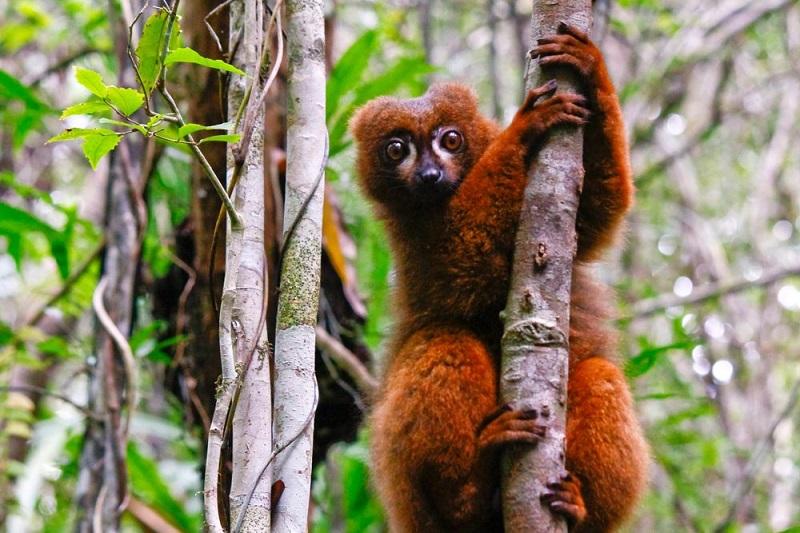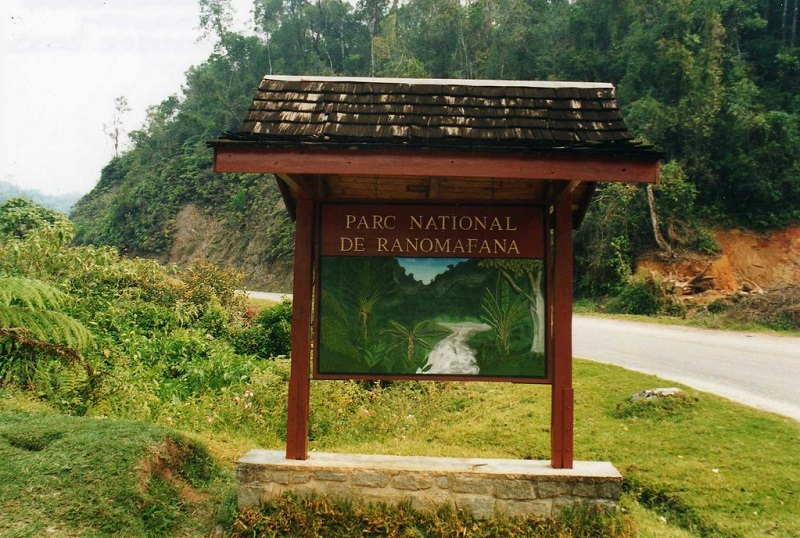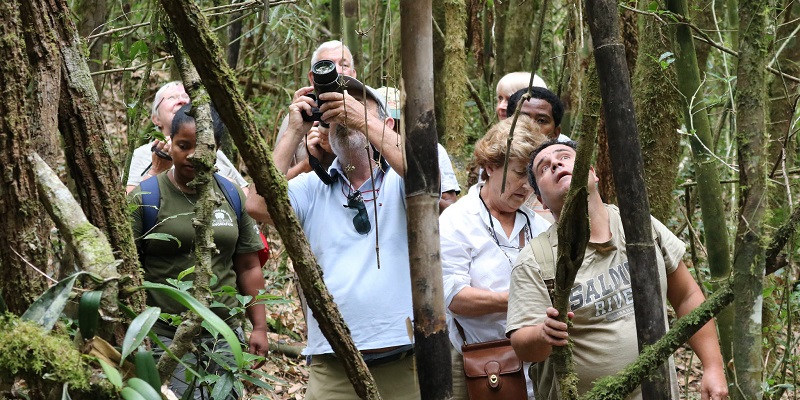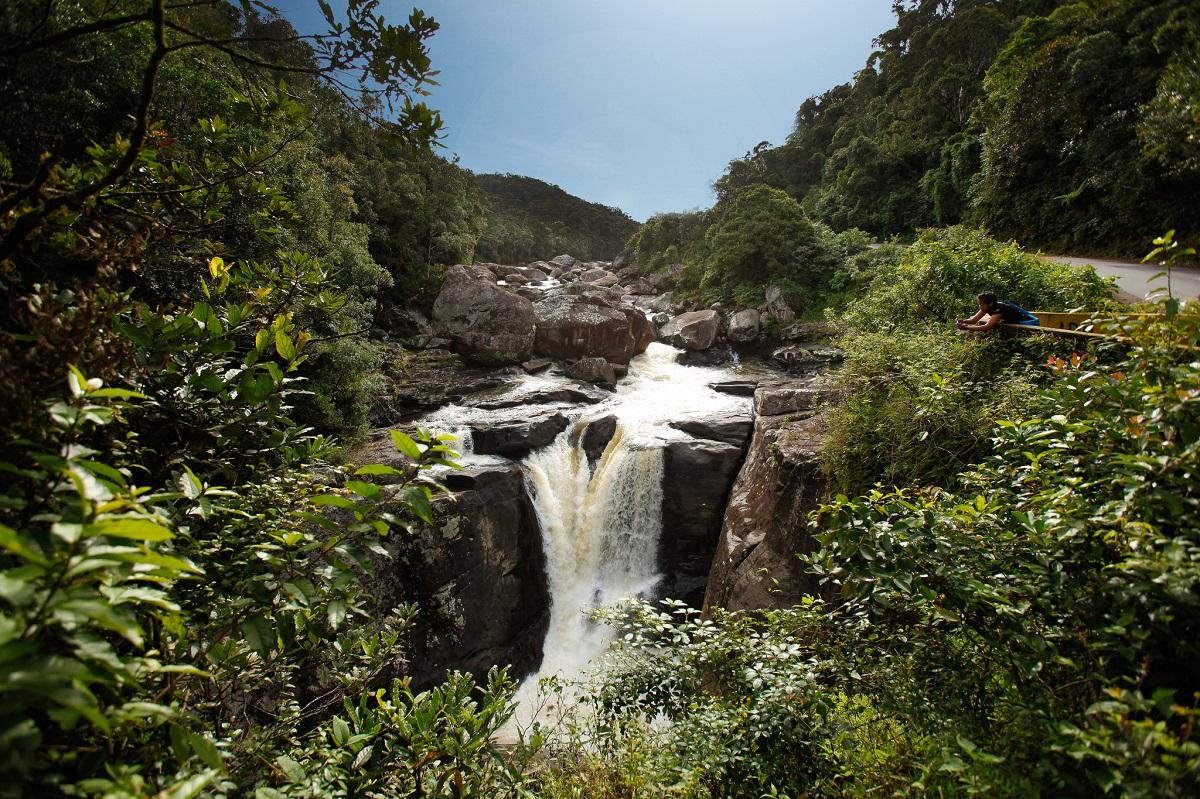Located in southeastern Madagascar, Ranomafana National Park is renowned for its extraordinary biodiversity and lush rainforests. Established in 1991, the park spans around 41,600 hectares and is part of a larger protected area that includes various ecosystems.
Its name, which translates to “hot water,” references the thermal springs found within the park, adding a unique aspect to its natural charm. The park is home to over 12 species of lemurs, including the critically endangered golden bamboo lemur, making it a vital site for primate conservation efforts.
In addition to its rich wildlife, Ranomafana features breathtaking landscapes, including cascading waterfalls, dense forests and panoramic mountain views. This makes it a popular destination for eco-tourism and outdoor enthusiasts seeking to experience Madagascar’s unique flora and fauna.
Please Download Our Mobile App here
Overview of Ranomafana National Park
Ranomafana National Park is characterized by its hilly terrain, deep valleys and diverse ecosystems. The park’s altitude ranges from 800 to 1,400 meters, leading to varied microclimates that support a wide range of plant and animal life. The dense rainforests are rich in endemic species, with many plants and animals found nowhere else in the world.
The park’s varied habitats include montane forests, marshlands, and rivers, all contributing to its ecological significance. This biodiversity hotspot is recognized as a UNESCO World Heritage Site, emphasizing its global importance.
In addition to its wildlife, the park is home to numerous waterfalls, the most notable being the Namorona Falls, which offers stunning views and opportunities for photography and exploration. The unique combination of ecology, culture, and scenery makes Ranomafana an essential visit for anyone interested in Madagascar’s natural heritage.
Wildlife in Ranomafana National Park

Ranomafana National Park is celebrated for its remarkable biodiversity, housing more than 150 species of vertebrates, including reptiles, amphibians and birds. Among its most famous inhabitants are the 12 species of lemurs, with the golden bamboo lemur being one of the most sought-after sightings for visitors.
This species is particularly significant, as it was discovered only in 1986 and has become a symbol of conservation efforts in Madagascar. The park is also home to various endemic birds, such as the velvet asity and the pitta-like ground roller, making it a haven for birdwatchers. Additionally, Ranomafana boasts a rich diversity of plant life, including medicinal plants used by local communities.
The vibrant ecosystem supports countless species of insects and other invertebrates, playing a crucial role in the park’s ecological balance. The chance to observe such unique wildlife in their natural habitats enhances the experience for visitors, making each trip to the park memorable.
Best Time to Visit Ranomafana National Park
The best time to visit Ranomafana National Park is during the dry season, which typically runs from May to October. During this period, the weather is cooler and less humid, making it more comfortable for hiking and wildlife spotting. The dry season also coincides with the peak of lemur activity, increasing the chances of encountering these fascinating creatures.
However, the wet season, from November to April, brings heavy rainfall, transforming the landscape into a lush green paradise. While this season can make some trails muddy and challenging, it is also an excellent time for birdwatching, as many migratory birds visit the area.
You should consider their specific interests when planning their trip, as both seasons offer unique experiences. Overall, visiting during the dry season is recommended for optimal wildlife viewing and outdoor activities, while the wet season provides a more vibrant and colorful landscape.
Getting to Ranomafana National Park

Reaching Ranomafana National Park involves traveling to the town of Ranomafana, which is about 10 kilometers from the park entrance. The nearest major city is Fianarantsoa, located nearly 65 kilometers away, which serves as a common starting point for travelers. From Fianarantsoa, visitors can hire a taxi-brousse (shared taxi) or private vehicle to reach the park.
The roads leading to Ranomafana can be rough and bumpy, particularly during the rainy season, so a 4×4 vehicle is recommended. Once in the park, several well-maintained trails allow for easy exploration of its diverse landscapes.
Local guides are available at the park entrance to provide valuable insights and enhance the overall experience, helping visitors navigate the trails and spot wildlife. It’s advisable to arrange transportation in advance and consult with local operators to ensure a smooth journey to this stunning national park.
Other Activities in Ranomafana National Park
Ranomafana National Park offers a variety of activities for visitors looking to immerse themselves in its natural beauty and wildlife. Guided hikes are the most popular option, allowing guests to explore the park’s extensive trail system while learning about its unique flora and fauna. These hikes can be tailored to different skill levels and interests, from easy walks to challenging treks that may lead to breathtaking viewpoints or secluded waterfalls.
Night walks are also a highlight, providing a rare opportunity to observe nocturnal creatures, such as the elusive mouse lemur and various species of frogs. Birdwatching is another rewarding activity, as the park is home to over 100 bird species, including several endemic varieties.
For those interested in cultural experiences, visiting local villages near the park can provide insights into the traditions and lifestyles of the Malagasy people. Overall, Ranomafana offers a rich array of activities, ensuring that every visitor finds something to enjoy.
Park Fees for Ranomafana National Park

The entrance fees for Ranomafana National Park vary depending on nationality and age. For non-residents, the entry fee is about $15 per adult and around $5 per child. Residents of Madagascar benefit from significantly lower fees, generally around MGA 1,000 (less than $1) for adults and MGA 500 for children.
Additional costs may apply for guided tours, which are highly recommended to enhance the visitor experience, as well as for night walks and specific activities like birdwatching or visits to thermal springs. It’s advisable to check for any changes in fees or specific requirements before planning a visit, as they can fluctuate seasonally or due to park management updates.
FAQs
How do I get to Ranomafana National Park?
The park is located near the town of Ranomafana, roughly 65 kilometers from Fianarantsoa. Visitors can reach the park by taxi-brousse or private vehicle.
What wildlife can I expect to see in the park?
Ranomafana is home to over 12 species of lemurs, including the golden bamboo lemur, as well as many endemic birds, reptiles, and a variety of plant species.
Is it safe to hike in the park?
Yes, hiking is safe when guided by local experts, who can navigate the trails and enhance your understanding of the park’s ecosystem.
Conclusion
Ranomafana National Park is a gem in Madagascar, offering an unparalleled opportunity to experience the country’s unique biodiversity and stunning landscapes. Its rich wildlife, diverse ecosystems, and array of activities make it a must-visit destination for nature lovers and adventurers alike.



